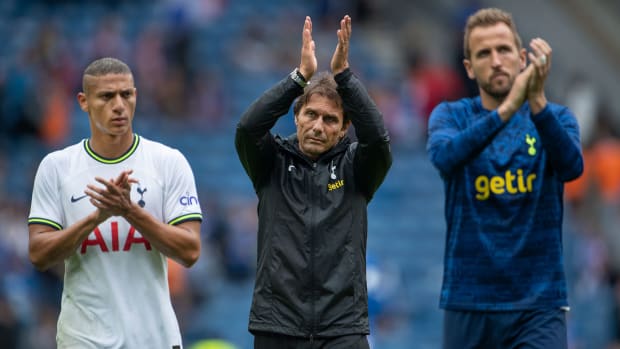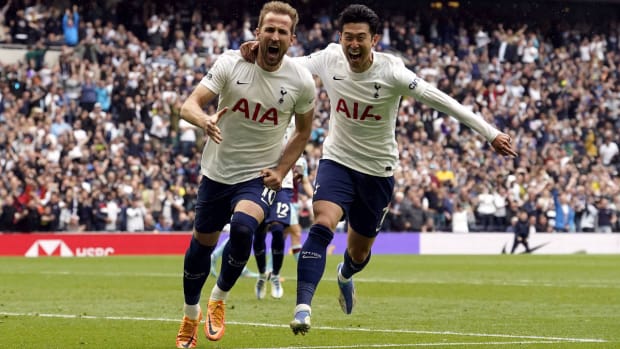This has been a very unfamiliar summer for Tottenham. The offseason months in Spurs’ portion of north London are usually time for introspection and frustration, anxiously fretting that key assets may be sold while frustration mounts at Daniel Levy’s policy of brinksmanship with signings as he seeks the best possible price even at the expense of proper planning for the campaign to come. But this summer, after all the doubts in the spring about Antonio Conte’s future, business has been handled early, and there is a clear mood of optimism at Tottenham Hotspur Stadium.
Conte, in truth, was never going to have it any other way. If there had been stalling on new signings, he would almost certainly have left by now. In total, there have been seven players brought in on permanent deals, five of whom have a realistic prospect of making an impact on the first team this season (plus center back Clément Lenglet, added on loan from Barcelona). Although there have been six departures, plus three on loan, only Steven Bergwijn and Joe Rodon were remotely close to the first team. The result is a much deeper squad, one with variety and versatility—and that means the expectation should be of a top-four finish and, perhaps, if others struggle, something more.
Richarlison, at a club-record $73 million, was the biggest summer signing. The 25-year-old is not merely a potent attacking presence, contributing 10 goals and five assists for a poor Everton side last season, but is also a diligent presser, in the top 8% of forwards across Europe for each of pressures made, tackles, interceptions, blocks and clearances. That should make him ideally suited to Conte’s football, and he offers the advantage that he can play anywhere across the forward line, reducing the pressure on the front three that ended last season so impressively: Dejan Kulusevski, Harry Kane and Son Heung-min.

Visionhaus/Getty Images
Just as significant, though, may be the $30 million purchase of Yves Bissouma from Brighton. Spurs have lacked a really commanding central midfield presence for years, but the Mali international offers a compelling blend of aggression, positional awareness and passing. He should be able both to offer protection to the back four, while having the capacity to transfer the ball rapidly from front to back.
Ivan Perišić, at 33, is perhaps a riskier signing (though he came as a free agent), but he has prospered under Conte before, can play in a range of positions, and so offers useful cover even if his most likely starting position is at left wingback. Djed Spence, meanwhile, at 21, is a hugely promising attacking right back, who should be able to offer something similar on the opposite flank. Sergio Reguilón, Ryan Sessegnon, Emerson Royal and Matt Doherty remain in the squad, but none of them entirely convinced in the wingback position last season. Given how physically demanding the role is, it’s probably just as well to have multiple options.
Fraser Forster’s arrival on a free transfer is surely to be a backup, but given the occasional wobble from Hugo Lloris in recent years, additional experience in goal is probably a wise move as well. This feels like a summer of identifying weak points or areas that demand improvement and signing solutions, both the most focused and wide-ranging window Tottenham has had for years.
There was a clear upswing in form toward the end of last season, four wins plus a draw at Liverpool in the final five games of the season, which carried Spurs into the Champions League places. That suggested that after some turbulent months Tottenham had finally grasped the Conte way of doing things and that process of assimilation should only have been accelerated after a full preseason.

Andrew Matthews/PA Images/Imago Images
Certainly fitness should be better. Spurs were one of the best-conditioned sides in the country under Mauricio Pochettino, but that fell away under the less press-oriented approaches of José Mourinho and Nuno Espírito Santo. There was a limit to what Conte could do to improve that mid-season, but there has been plenty of video this summer of players throwing up during sprint sessions. It may be that does little to help players physically, but what it does do is help condition them psychologically to be able to push through discomfort. It is, as much as anything, a bonding exercise.
But for all the optimism, what is a realistic target for Spurs? Manchester City and Liverpool, in truth, are probably a little too far head in quality, although a midseason World Cup may introduce a randomness factor. Chelsea, struggling to add new signings, may be in range, but the most realistic target, perhaps, is a run in the Champions League and a serious crack in the domestic cups, with hopes of ending a trophy drought that goes back to 2008. The foundation has been set, and the pieces, it feels, are in place.







